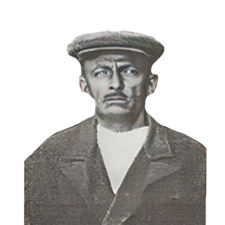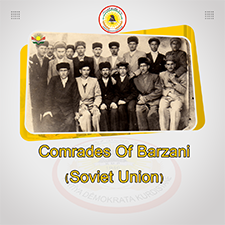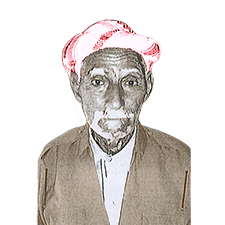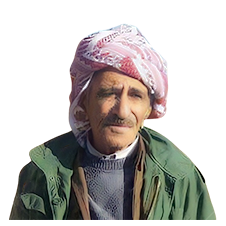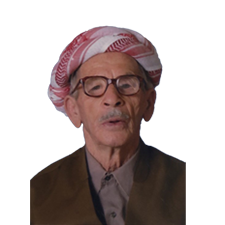Biography:
Brahim Hassan was born in the village of Bebel in Erbil in 1910. Before he left for the Soviet Union, he had a family, and his wife’s name was Gull Khdr. He also had a son called Hussain Ibrahim born in 1941 and a daughter named Halima Ibrahim born in 1942.
Brahim was one of those that aided general Mustafa Barzani on 15/5/1947 in the meeting that was conducted with the comrades in the village of “Argush”, and they were granted the freedom in whether to stay or go to the Soviet Union. Everyone decided to leave and go to the Soviet Union. On the 23rd of May in 1947, Brahim travels with General Mustafa to the Soviet Union and fought in the battles of “Gali Qtur” and the “Mako” bridge. After a lot of hardships, on the 18th of June in 1947, Brahim was able to travel to the Soviet Union after passing through the Aras River which was between the borders of Iran and the Soviet Union.
After their arrival to the Soviet Union on the 19th of June in 1947 in the city of “Nakhchawan” in the Republic of Azerbaijan, for forty days, all of the comrades were placed in a community that was surrounded by barbed wire. They were being monitored by the soldiers and were treated like hostages of war when it came to food and clothes. Afterwards, the Soviet government decided that the comrades should be divided into the places of “Aghdam”, “Lachin”, “Ayulax” and “Kalbajar” in the Republic of Azerbaijan. On the 10th of December in 1947, they were transported to a military camp on the lake of “Khazar” in the capital of the Republic of Mahabad “Bakor”. On the 23rd of the same month, they were given military clothes and were trained by the officers of the republic 8 hours a day. On top of that, some of the comrades that were literate in Kurdish would teach the language for 4 hours a day.
After the ill-treatment of “Jaafar Baqrov” with the comrades, on the 29th of August in 1949, Barzani decides to transport his military camp from the republic of Mahabad to a “Chrchuk” community near the city of “Tashkand” which was the capital of Uzbekistan; there they continued their military practices.
In March 1949, the comrades were divided into the villages of the Soviet Union and farms (where civilians would rent them from the governments and pay them back later). The comrades were working in these places.
Following multiple letters to Stalin by General Barzani, a letter finally reaches Stalin where it talks about the hardships the comrades are going through. Stalin immediately creates a party to investigate the comrades of Barzani; the party comes to the decision that everyone should gather in the city of “Vrivsky”. Brahim travels to the city in November of 1951.
After the July 14, 1958, revolution in Iraq and the return of General Mustafa Barzani, on February 25, 1959, according to both Articles 3 and 7, paragraph (a) of Article 10 and according to Article (11), and based on the amended law No. 19, General Mustafa Barzani and his comrades were granted a general amnesty.
Brahim along with his comrades travelled back to Kurdistan with the ship “Grozya” through the harbor of “Basra” in the southern Iraq on 16th of April in 1959. In 1961, he participated in the Aylul revolution and was the leader of the pal (the pheshmarga group of 30 to 50 peshmargas). In the same year, he was killed on the Qalandar mountain.
Sources:
- حهمید گهردی، پوختهی مێژوونامه، چاپی یهكهم، (ههولێر - دهزگای چاپ و بڵاوكردنهوهی ئاراس - چاپخانهی وهزارهتی پهروهرده - ٢٠٠٤)
- له یادداشتی فهرماندهی شههید حهسۆ میرخان ژاژۆكی، ٦٢ ڕۆژ لهگهڵ بارزانی دا، چوونی بارزانییهكان بۆ یهكێتی سۆڤێت، چاپی یهكهم (ههولێر - چاپخانهی ڕۆشنبیری - ١٩٩٧).
- مسعود بارزانی، بارزانی و بزوتنهوهی رزگاریخوازی كورد ١٩٣١-١٩٥٨، (دهۆك - چاپخانهی خهبات - ١٩٩٨).
- ئەرشیفی دەستەی ئینسکلۆپیدیا، فۆڕمی برایم حهسهن برایم (ئیبراهیم حهسهن ئیبراهیم)، لە ڕێکەوتی ١ تشرینی دووهمی ٢٠١٨- پیرمام.
- نص قرار لجنة العفو العام برد الاعتبار الى شهداء ثورة بارزان، مجلة رزگاری، العدد٣،٢، المطبعة الرابطة، بغداد، ١ نيسان ١٩٥٩.




